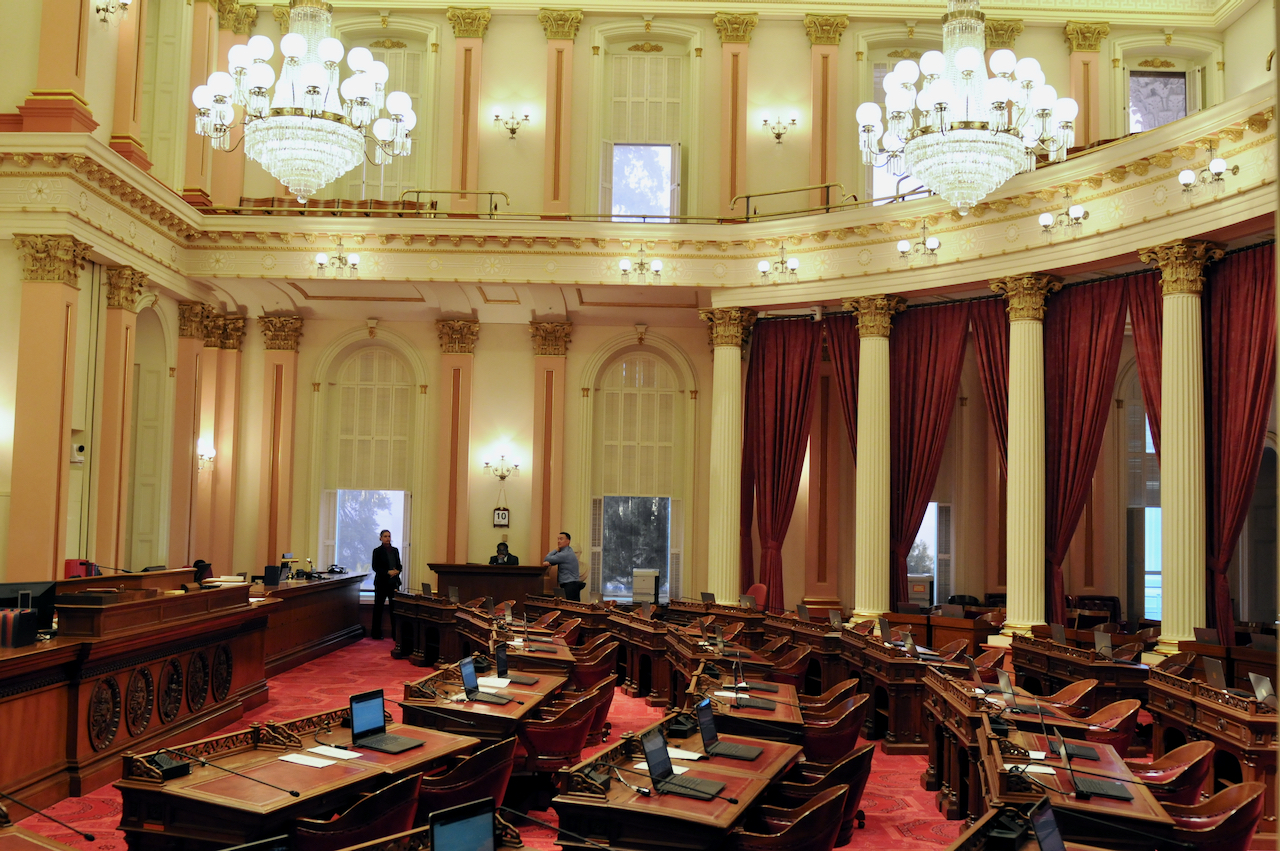
Assembly Chambers. (Photo: Kevin Sanders for California Globe)
‘Spot Bills’ in the California Legislature
These bills are merely placeholders for future language
By Chris Micheli, May 13, 2019 6:32 am
During the first two months generally of the California Legislative Session, over 2,500 bills are usually introduced. Hundreds of those bills are “spot bills” or “intent bills.” What are they and why are they used?
In the State Assembly this year, there were 1,799 bills introduced by the deadline, with over 600 of those measures being spot bills or about 1/3 of the introduced bills. Amendments to nearly 500 of those spot bills were submitted by the deadline.
In the State Senate this year, there were 777 bills introduced by the deadline, including 231 spot bills, or roughly 30 percent of the measures introduced.
As described by the Legislative Counsel, a “spot bill” is one that does not make any substantive change to existing law, “and would not otherwise affect the ongoing operations of state or local government.”
Defined
As described by the Legislative Counsel, a “spot bill” is one that does not make any substantive change to existing law, “and would not otherwise affect the ongoing operations of state or local government.” An “intent bill” is one that merely makes a statement of legislative intent.
- In both instances, these bills upon introduction are merely placeholders for future language. They do not make any substantive changes to existing law. By the rules of the Assembly and Senate, spot bills or intent bills may not be referred to a policy committee unless and until the bill is amended to make a substantive change in the law.
Their Use
Now that we understand what they are, why are they used? Because the California Legislative Session is dependent upon its deadlines, including a deadline for introducing bills, sometimes legislators do not have their bill proposals fully prepared by that time. As such, they need to introduce a “placeholder” bill and then develop or finalize their substantive bill language.
Rules
While there are not specific rules to spot bills in the Senate Rules or the Joint Rules, there is one in the Assembly Rules. AR 51.5 reads as follows:
Spot Bills
51.5.A bill that upon introduction makes no substantive change in or addition to existing law, and would not otherwise affect the ongoing operations of state or local government, except a bill stating legislative intent to make necessary statutory changes to implement the Budget Bill, may not be referred to a committee by the Committee on Rules. If the author subsequently proposes to the Committee on Rules to make substantive changes in the bill as introduced, the Committee on Rules may refer the bill to a committee, together with the proposed changes for consideration as author’s amendments. A vote on passage of the bill may not be taken, however, until the bill with its amendments, if adopted, has been in print for at least 15 days.
From the 2019 Legislative Session, the following are examples of a spot bill and an intent bill:
Spot Bill Example
SB 362, as introduced, Roth. Legal remedies.
Existing law encompasses provisions pertaining to the civil law of the state, including laws concerning persons, property, and obligations, among other subjects. Existing law provides for relief or remedy for violation of private rights and to secure observance of those rights. Existing law prohibits specific or preventative relief in cases, except as specified. This bill would make nonsubstantive changes to those provisions.
DIGEST KEY
Vote: majority Appropriation: no Fiscal Committee: no Local Program: no
THE PEOPLE OF THE STATE OF CALIFORNIA DO ENACT AS FOLLOWS:
SECTION 1.
Section 3274 of the Civil Code is amended to read:
3274. As a general rule, compensation is the relief or remedy provided by the law of this State state for the violation of private rights, rights and the means of securing their observance; and specific observance. Specific and preventive relief may be given in no other cases than those specified in this Part of the CivilCode part.
Intent Bill Example
AB 106, as introduced, Ting. Budget Act of 2019.
This bill would express the intent of the Legislature to enact statutory changes relating to the Budget Act of 2019.
DIGEST KEY
Vote: majority Appropriation: no Fiscal Committee: no Local Program: no
THE PEOPLE OF THE STATE OF CALIFORNIA DO ENACT AS FOLLOWS:
SECTION 1.
It is the intent of the Legislature to enact statutory changes relating to the Budget Act of 2019.
Assembly Process
In the Assembly, a deadline is specified each year, which is set a few weeks after the bill introduction deadline. That deadline is to get amendments to spot or intent bills to the Committee on Rules. Once the Rules Committee reviews the proposed amendments, the Rules Committee refers the bill and its amendments to the relevant policy committee. Thereafter, the committee processed the amendments to the bill.
Senate Process
In the Senate, there is no deadline specified for getting amendments to the Rules Committee. However, those amendments must be submitted within sufficient time for the Rules Committee to refer to the amended bill to committee for a hearing before the relevant deadline. The bill’s amendments are submitted to the Committee on Rules and the Rules Committee makes the amendments to the bill. Thereafter, the bill is referred to the relevant policy committee.
- Exemptions from Tax Withholding in California - July 23, 2024
- General Provisions of California’s Evidence Code - July 22, 2024
- Judicial Notice Under the California Evidence Code - July 21, 2024





3 thoughts on “‘Spot Bills’ in the California Legislature”